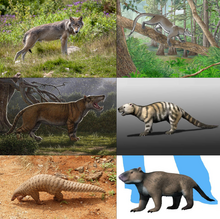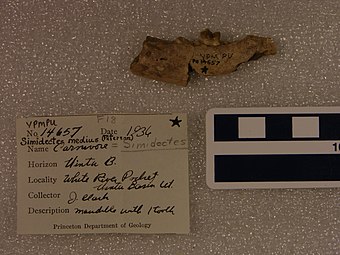Ferae
| Ferae | |
|---|---|

| |
| Scientific classification | |
| Domain: | Eukaryota |
| Kingdom: | Animalia |
| Phylum: | Chordata |
| Class: | Mammalia |
| Grandorder: | Ferungulata |
| Mirorder: | Ferae Linnaeus, 1758[2] |
| Subgroups | |
|
[see classification]
| |
| Synonyms | |
Ferae (/ˈfɪəriː/ FEER-ee, Latin: [ˈfɛrae̯], "wild beasts") is a mirorder of placental mammals[9][10] in grandorder Ferungulata, that groups together clades Pan-Carnivora (that includes carnivorans and their fossil relatives) and Pholidotamorpha (pangolins and their fossil relatives).
General characteristics
[edit]In mirorder Ferae
[edit]The common feature for members of this mirorder is ossified tentorium cerebelli and the fusion of the scaphoid and lunate bones in the wrist.[11][12]
Thinocyon medius
In clade Pan-Carnivora
[edit]The common features for members of clade Pan-Carnivora are:
- heterodont teeth that are sharp and for cutting meat,
- canine teeth that are usually large, conical, pointed, thick and stress resistant,
- and presence of the carnassial teeth.
Carnassials are feature that allows distinguishing the Carnivoramorpha, Oxyaenodonta and Hyaenodonta from the other carnivorous placental mammals.[11] However, these mammals are distinguished between themselves based on the position of the carnassial teeth and the number of molars. The carnassial teeth of the Carnivoramorpha are located in P4 and m1, in Oxyaenodonta are M1 and m2, and in Hyaenodonta and close relatives are M2 and m3. This appears to be a case of a possible evolutionary convergent adaptation toward similar diet.[11]
Classification and phylogeny
[edit]Sister groups to Ferae
[edit]According to recent studies, the closest relatives of Ferae are members of clade Pan-Euungulata (group that includes mirorder Euungulata[13][14] and extinct genus Protungulatum). Together they form grandorder Ferungulata.
An alternate phylogeny holds that the closest relative to Ferae is order Perissodactyla, with whom they form a clade Zooamata. Together, clade Zooamata and order Chiroptera form clade Pegasoferae,[15] and Pegasoferae is sister taxon to order Artiodactyla within clade Scrotifera. However, subsequent molecular studies have generally failed to support this proposal.[16][17][18][19][20]
Position of pangolins and creodonts within clade
[edit]Pangolins were long thought to be the closest relatives of aardvark and xenarthrans, forming to the now obsolete order Edentata. Research based on immunodiffusion technique[21] and comparison of protein and DNA sequences[22][23][24] revealed the close relationships between pangolins and carnivorans, with whom they also share a few unusual derived morphological and anatomical traits, such as the ossified tentorium cerebelli and the fusion of the scaphoid and lunate bones in the wrist. The last common ancestor of extant Ferae is supposed to have diversified c. 79.47 million years ago.[1]
While there has been strong support in the inclusion of order Creodonta into Ferae, they were usually recovered as sister taxon to order Carnivora.[9] The Halliday et al. (2015) phylogenetic analysis of hundreds of morphological characters of Paleocene placentals found instead that creodonts might be the sister group to Pholidotamorpha (pangolins and their stem-relatives).[25] However, recent studies have shown that Creodonta is an invalid polyphyletic taxon. Members of this group are now part of clade Pan-Carnivora and sister taxa to Carnivoramorpha (carnivorans and their stem-relatives), split in two groups: order Oxyaenodonta on one side and on the other side order Hyaenodonta plus its stem-relatives, like family Wyolestidae (that only contains genus Wyolestes),[26] genus Simidectes[27][28] and clade made of genera Altacreodus and Tinerhodon.[29][30][31][32][33]
Taxonomy
[edit]| Former classification (McKenna & Bell, 1997):[10] | Current classification: |
|---|---|
|
|
Alternative classification and possible fossil members
[edit]In Halliday et al. (2015) various enigmatic Palaeocene eutherian mammals have been proposed to be possible members of Ferae, like members of orders Mesonychia, Pantodonta and Taeniodonta, and families Arctocyonidae, Didelphodontidae, Nyctitheriidae, Palaeoryctidae, Periptychidae and Triisodontidae.[25] Mesonychians are proposed to be a sister group to carnivoramorphs, while arctocyonids were polyphyletic, with genera Arctocyon and Loxolophus as a sister taxa to pantodonts and periptychids, Goniacodon and Eoconodon sister to the Carnivoramorpha-Mesonychia clade, and other genera allied with creodonts and palaeoryctids.[25] This enlarged Ferae was also found to be the sister group to order Chiroptera,[25] even though recent studies dispute this classification.[35][36]
See also
[edit]References
[edit]- ^ a b Sean P. Heighton, Rémi Allio, Jérôme Murienne, Jordi Salmona, Hao Meng, Céline Scornavacca, Armanda D. S. Bastos, Flobert Njiokou, Darren W. Pietersen, Marie-Ka Tilak, Shu-Jin Luo, Frédéric Delsuc, Philippe Gaubert (2023.) "Pangolin genomes offer key insights and resources for the world’s most trafficked wild mammals"
- ^ "'Ferae' – The Linnean Collections". linnean-online.org. Retrieved 26 February 2020.
- ^ Haeckel, Ernst (1866.) "Generelle Morphologie der Organismen." Berlin: Georg Reimer.
- ^ Haeckel, Ernst (1895). Systematische Phylogenie: Wirbelthiere (in German). Vol. T.3. Berlin: G. Reimer.
- ^ Zagorodniuk, I. (2008.) "Scientific names of mammal orders: from descriptive to uniform" Visnyk of Lviv University, Biology series, Is. 48. P. 33-43
- ^ Kalandadze, N. N. and S. A. Rautian (1992.) "Systema mlekopitayushchikh i istorygeskaya zoogeographei [The system of mammals and historical zoogeography]." Sbornik Trudov Zoologicheskogo Muzeya Moskovskogo Goschdarstvennoro Universiteta 29:44–152.
- ^ Edward Newman (1843.) "The Zoologist: a monthly journal of natural history. (Vol. 1)", London, J. Van Voorst
- ^ Amrine-madsen, H.; Koepfli, K.P.; Wayne, R.K.; Springer, M.S. (2003). "A new phylogenetic marker, apolipoprotein B, provides compelling evidence for eutherian relationships". Molecular Phylogenetics and Evolution. 28 (2): 225–240. doi:10.1016/S1055-7903(03)00118-0. PMID 12878460.
- ^ a b McKenna, M. C. (1975). "Toward a phylogenetic classification of the Mammalia". In Luckett, W. P.; Szalay, F. S. (eds.). Phylogeny of the Primates. New York: Plenum. pp. 21–46.
- ^ a b McKenna, M. C.; Bell, S. K. (1997). Classification of Mammals: Above the Species Level. Columbia University Press. p. 631. ISBN 978-0-231-52853-5. Retrieved 16 September 2024.
- ^ a b c Floréal Solé & Thierry Smith (2013.) "Dispersals of placental carnivorous mammals (Carnivoramorpha, Oxyaenodonta & Hyaenodontida) near the Paleocene-Eocene boundary: a climatic and almost worldwide story" Geologica Belgica 16/4: 254–261
- ^ Gaudin, Timothy J.; Gaubert, Philippe; Billet, Guillaume; Hautier, Lionel; Ferreira-Cardoso, Sérgio; Wible, John R. (1 January 2020), Challender, Daniel W. S.; Nash, Helen C.; Waterman, Carly (eds.), "Chapter 1 – Evolution and morphology", Pangolins, Biodiversity of World: Conservation from Genes to Landscapes, Academic Press, pp. 5–23, doi:10.1016/b978-0-12-815507-3.00001-0, ISBN 978-0-12-815507-3, S2CID 214085088, retrieved 26 February 2020
- ^ Beck, Robin MD; Bininda-Emonds, Olaf RP; Cardillo, Marcel; Liu, Fu-Guo; Purvis, Andy (13 November 2006). "A higher-level MRP supertree of placental mammals". BMC Evolutionary Biology. 6 (1): 93. doi:10.1186/1471-2148-6-93. PMC 1654192. PMID 17101039.
- ^ Zhou, X.; et al. (2011). "Phylogenomic analysis resolves the interordinal relationships and rapid diversification of the Laurasiatherian mammals". Systematic Biology. 61 (1): 150–64. doi:10.1093/sysbio/syr089. PMC 3243735. PMID 21900649. (Advance Access; published online 7 September 2011)
- ^ Nishihara, H.; Hasegawa, M; Okada, N (2006). "Pegasoferae, an unexpected mammalian clade revealed by tracking ancient retroposon insertions". Proceedings of the National Academy of Sciences. 103 (26): 9929–34. Bibcode:2006PNAS..103.9929N. doi:10.1073/pnas.0603797103. PMC 1479866. PMID 16785431.
- ^ Matthee, Conrad A.; Eick, Geeta; Willows-Munro, Sandi; Montgelard, Claudine; Pardini, Amanda T.; Robinson, Terence J. (2007). "Indel evolution of mammalian introns and the utility of non-coding nuclear markers in eutherian phylogenetics". Molecular Phylogenetics and Evolution. 42 (3): 827–837. doi:10.1016/j.ympev.2006.10.002. PMID 17101283.
- ^ Springer, M.S.; Burk-Herrick, A.; Meredith, R.; Eizirik, E.; Teeling, E.; O'Brien, S.J.; Murphy, W.J. (2007). "The adequacy of morphology for reconstructing the early history of placental mammals". Systematic Biology. 56 (4): 673–684. doi:10.1080/10635150701491149. PMID 17661234.
- ^ Kitazoe, Yasuhiro; Kishino, Hirohisa; Waddell, Peter J.; Nakajima, Noriaki; Okabayashi, Takahisa; Watabe, Teruaki; Okuhara, Yoshiyasu (2007). Hahn, Matthew (ed.). "Robust Time Estimation Reconciles Views of the Antiquity of Placental Mammals". PLOS ONE. 2 (4): e384. Bibcode:2007PLoSO...2..384K. doi:10.1371/journal.pone.0000384. PMC 1849890. PMID 17440620.
- ^ Zhou, Xuming; Xu, Shixia; Xu, Junxiao; Chen, Bingyao; Zhou, Kaiya; Yang, Guang (2011). "Phylogenomic Analysis Resolves the Interordinal Relationships and Rapid Diversification of the Laurasiatherian Mammals". Systematic Biology. 61 (1): 150–164. doi:10.1093/sysbio/syr089. PMC 3243735. PMID 21900649.
- ^ Tsagkogeorga, G; Parker, J; Stupka, E; Cotton, JA; Rossiter, SJ (2013). "Phylogenomic analyses elucidate the evolutionary relationships of bats (Chiroptera)". Current Biology. 23 (22): 2262–2267. doi:10.1016/j.cub.2013.09.014. PMID 24184098. S2CID 9133016.
- ^ Shoshani, J. (1 May 1986). "Mammalian phylogeny: comparison of morphological and molecular results". Molecular Biology and Evolution. 3 (3): 222–242. doi:10.1093/oxfordjournals.molbev.a040389. ISSN 0737-4038. PMID 3127652.
- ^ Shoshani, Jeheskel; Goodman, Morris; Czelusniak, John; Braunitzer, Gerhard (1985). "A Phylogeny of Rodentia and Other Eutherian Orders: Parsimony Analysis Utilizing Amino Acid Sequences of Alpha and Beta Hemoglobin Chains". In Luckett, W. Patrick; Hartenberger, Jean-Louis (eds.). Evolutionary Relationships among Rodents. NATO Advanced Science Institutes (ASI) Series. Boston, MA: Springer US. pp. 191–210. doi:10.1007/978-1-4899-0539-0_7. ISBN 978-1-4899-0539-0.
- ^ Madsen, Ole; Scally, Mark; Douady, Christophe J.; Kao, Diana J.; DeBry, Ronald W.; Adkins, Ronald; Amrine, Heather M.; Stanhope, Michael J.; de Jong, Wilfried W.; Springer, Mark S. (2001). "Parallel adaptive radiations in two major clades of placental mammals". Nature. 409 (6820): 610–614. Bibcode:2001Natur.409..610M. doi:10.1038/35054544. ISSN 1476-4687. PMID 11214318. S2CID 4398233.
- ^ Murphy WJ, Eizirik E, et al. (14 December 2001). "Resolution of the Early Placental Mammal Radiation Using Bayesian Phylogenetics". Science. 294 (5550): 2348–2351. Bibcode:2001Sci...294.2348M. doi:10.1126/science.1067179. PMID 11743200. S2CID 34367609.
- ^ a b c d Halliday, Thomas J. D.; Upchurch, Paul; Goswami, Anjali (2015). "Resolving the relationships of Paleocene placental mammals" (PDF). Biological Reviews. 92 (1): 521–550. doi:10.1111/brv.12242. ISSN 1464-7931. PMC 6849585. PMID 28075073.
- ^ S. P. Zack, K. D. Rose, M. O'Leary (2022.) "New information on the enimgmatic Wyolestes and the affinities of genus", in "The Society of Vertebrate Paleontology 82nd annual meeting"
- ^ S. P. Zack and S. Tomiya (2016.) "New postcrania clarify the affinities of the unusual Eocene mammal Simidectes", in "The Society of Vertebrate Paleontology 76th annual meeting"
- ^ Tomiya, S.; Zack, S. P.; Spaulding, M.; Flynn, J. J. (2021). "Carnivorous mammals from the middle Eocene Washakie Formation, Wyoming, USA, and their diversity trajectory in a post-warming world". Journal of Paleontology. 95 (Supplement S82): 1–115. doi:10.1017/jpa.2020.74. hdl:2433/274918.
- ^ Borths, Matthew R; Stevens, Nancy J (2017). "Deciduous dentition and dental eruption of Hyainailouroidea (Hyaenodonta, "Creodonta," Placentalia, Mammalia)". Palaeontologia Electronica. 20 (3): 55A. doi:10.26879/776.
- ^ Solé, Floréal; Ladevèze, Sandrine (2017). "Evolution of the hypercarnivorous dentition in mammals (Metatheria,Eutheria) and its bearing on the development of tribosphenic molars". Evolution & Development. 19 (2): 56–68. doi:10.1111/ede.12219. PMID 28181377. S2CID 46774007.
- ^ Prevosti, F. J., & Forasiepi, A. M. (2018). "Introduction. Evolution of South American Mammalian Predators During the Cenozoic: Paleobiogeographic and Paleoenvironmental Contingencies"
- ^ Matthew R. Borths; Nancy J. Stevens (2019). "Simbakubwa kutokaafrika, gen. et sp. nov. (Hyainailourinae, Hyaenodonta, 'Creodonta,' Mammalia), a gigantic carnivore from the earliest Miocene of Kenya". Journal of Vertebrate Paleontology. 39 (1): e1570222. Bibcode:2019JVPal..39E0222B. doi:10.1080/02724634.2019.1570222. S2CID 145972918.
- ^ Floréal Solé; Bernard Marandat; Fabrice Lihoreau (2020). "The hyaenodonts (Mammalia) from the French locality of Aumelas (Hérault), with possible new representatives from the late Ypresian". Geodiversitas. 42 (13): 185–214. doi:10.5252/geodiversitas2020v42a13. S2CID 219585388.
- ^ J. J. Flynn, A. R. Wyss and M. Wolsan (2020.) "Pan-Carnivora, new clade name" In book: Phylonyms (pp.979–982)
- ^ Frank Zachos (2020.) "Mammalian Phylogenetics: A Short Overview of Recent Advances", In book: "Mammals of Europe – Past, Present, and Future" (pp.31–48)
- ^ Xue Lv, Jingyang Hu, Yiwen Hu, Yitian Li, Dongming Xu, Oliver A. Ryder, David M. Irwin, Li Yu (2021.) "Diverse phylogenomic datasets uncover a concordant scenario of laurasiatherian interordinal relationships", Molecular Phylogenetics and Evolution, Volume 157







